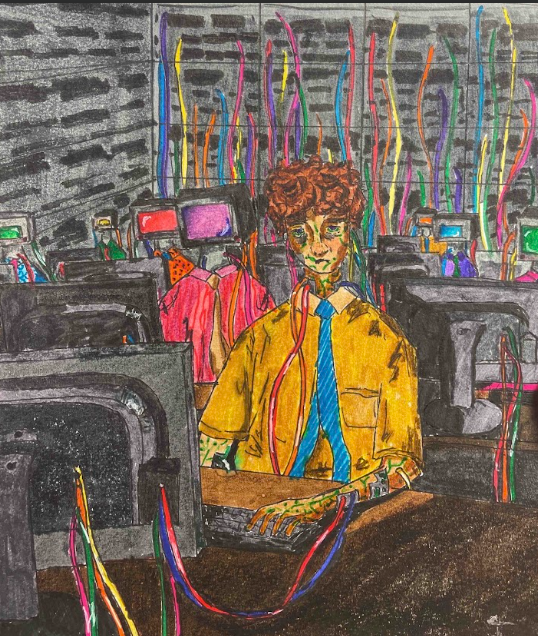I’ve always wondered why the masses are averse to change, but I admit we collectively play an active role in stifling innovation and suppressing new ideas.
After all, change is good. The very principles of American democracy blossomed after recognizing a need for change. I can almost guarantee the unconventionality of direct representation was thought to be as inconclusive as Darwin’s theory of Evolution. Today, no one bats an eye when discussing evolution or direct representation. I am not saying that change can’t be detrimental; it can. But, it is time we start embracing our modern changes as our forefathers embraced theirs at the time. Today, everywhere I look, there is conformity angst: we stop at a red traffic light, wait our turn in line at the grocery store, or are skeptical about AI use.
Regardless, adherence to seemingly mundane acts without stopping to ponder the value of our actions, in essence, is a manifestation of conformity.
But why let the notion of conformity disrupt human attempts to embrace technological advancements? Yes, ChatGPT. But when discussing this, I will assume there is a definite way for humans to “pull the plug” on the AI system if necessary.
But as I’ve experimented with AI technology and the transformative power of ChatGPT, I have grappled with these questions; “Why stifle and deny the faculty of AI-powered technology? Why reject the natural inclination? Why prohibit use? Why reject embracement?”
Let me pose one other question: Why do we allow the fear of disrupted human interaction complexities and predictability of order to drive the implementation of innovation?
No one can deny the urgency in Silicon Valley to roll out new AI-powered systems, but at the same time, we can’t expect to never see these technologies – We are at a moment when our reaction to this technology will determine the course of the future.
So, now is not the time to latch onto conformity but to start developing and teaching young people how to embrace and responsibly socialize with AI, beginning with ChatGPT.
While there are no strict guidelines on AI restrictions in the high school setting, faculty should be thoroughly educated on the benefits of AI implementation in the classroom before issuing a verdict on use. Frequently, educators at East and beyond associate AI with dishonesty, a lack of hard work on the student’s part, or just plain rejection of the technology. Not only is this negative association unwarranted – because students want to explore what is simply natural to them – it fosters a negative association with the socialization of AI and perpetuates a false narrative. In education, advisors are too quick to reject AI because they – themselves – remain uneducated on this technology’s benefits and capacity.
In this limbo state, we currently find ourselves in, with no clear regulations issued by educational advisory councils or the government, it falls to the educator to develop a policy that embraces AI in the classroom suitable to the evolving nature of the subject matter. We no longer need to follow traditional teaching styles or traditional learning methods. For teachers and students, socialization with AI will be the most critical skill in the coming years.
Still, some educators remain reluctant to implement AI into their classrooms, but why?
It is essential to recognize the evolving nature of education. Before, education was about remote skill memorization, but with pivots to value application, practicality in skill, and critical thinking, AI will prove to streamline, enhance, and even bolster any learning process; ChatGPT removes the fear of learning.
Steve Jobs once said, “Computers are the bicycles of the mind.” ChatGPT is a steam engine; now, not only can students do everything they did before – learn, critically think, reason – we can do it with this augmented tool that will enhance our ability.
Responsibly used and regulated, ChatGPT is not an excuse to quickly pass a class but a tool to enhance knowledge.
In an increasingly diverse classroom, AI has the potential to broaden students’ horizons: ChatGPT can be used to develop a thesis in an English class, develop a business proposal that would have gone undiscovered, or allow neurodivergent students to be included in the classroom. See, when we talk about AI in the classroom, I do not advocate for a simple “copy and paste,” but for harnessing the far-reaching power we can extrapolate from AI. Perhaps a student will learn the experience of his peers, and a child will learn democratic principles and hundreds of students will use this technology to learn concepts at record speeds.
So, who are we to stop this natural evolution of AI in the classroom?
This is our future; we can embrace it with open arms or stifle what is natural. AI incorporation will creep into the classroom eventually, so why not welcome it now?
The incentive structure of education is the root cause of unethical AI use – we should reconsider teaching and even reconceptualize AI tools as educational opportunities rather than threats to learning. We should use ChatGPT to help students in the idea-formation or learning process for any assignment as a study partner to bounce thoughts off. By teaching students how to apply AI tools for their benefit, clearly outlining expectations for ethical use, and encouraging transparency, educators could end up with tech-savvy pupils who would be less prone to let AI steer their educational ship.
We must also be careful not to deny the pathway to embracing technology. The speed of innovation is fast, and it remains crucial that we don’t get caught up in conformity and lose sight of the benefits of AI in the classroom. Rejecting these technological advancements on pre-formed notions aligned with conformist principles remains unacceptable.
So, educators and students alike should prioritize organizing methods to ethically use AI in the classroom that stakeholders deem appropriate.
In an ideal world, there will be a state of symbiosis between students and ChatGPT, like the relationship one can have with calculators and spellcheck.



